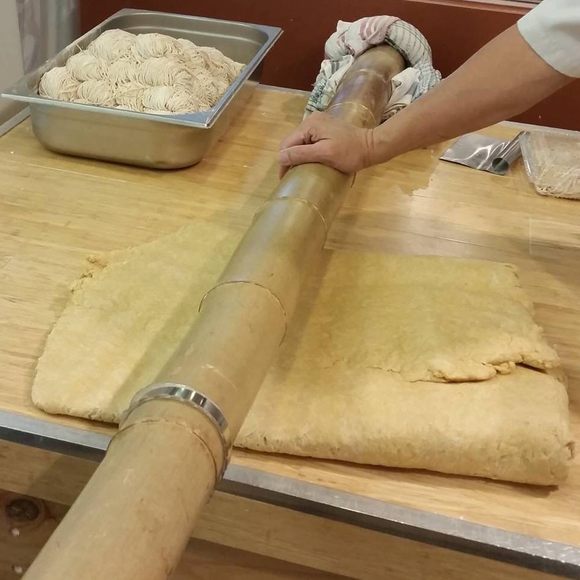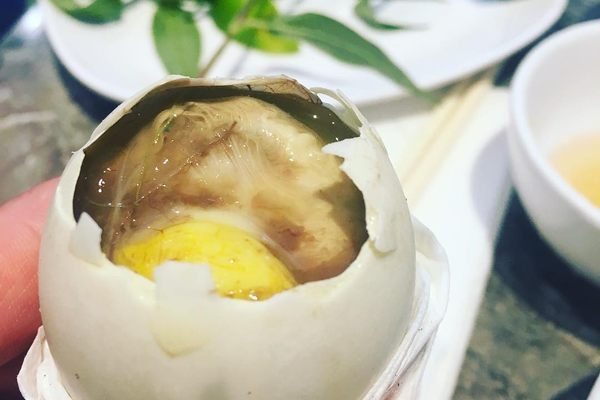How does a chef ensure his noodles have a distinct, intense bounce? By distinctly and intensely bouncing upon them.
In the early 20th century, street hawkers in the Chinese cities of Guangzhou and Macau hung their supplies from bamboo poles slung across their shoulders. At some point, Cantonese-style noodle vendors realized that the rod, which they harvested from nearby forests, could also flatten dough. By repurposing the bamboo, they freed themselves from the weight and cost of extra equipment.
To make the noodles, a street vendor first fashions jook-sing mein (bamboo pole noodle) dough. He tosses about 50 eggs—historically duck, though chicken is often included—into a pit of flour. Once he kneads the mixture into a stiff dough, it’s time to ride.
After hooking the bamboo rod through a loop, the noodle-maker sits on the end and bounces back and forth across the dough, in a motion that resembles riding a seesaw. Leveraging his weight allows him to flatten the layers into a thin sheet, giving the noodle their signature elasticity. Between 30 and 40 minutes later, he’ll deem the dough’s texture optimal and cut it into strips. After almost two hours of work, 100 servings of noodles are ready to be blanched and, most often, divvied into bowls of wonton soup.
The process is laborious, but manual jook-sing makers insist it’s the only way to give the noodles their characteristic springiness. Machines designed to flatten dough just can’t re-create the finesse of seasoned bamboo bouncers. But it’s a disappearing art. Younger generations are disinterested by the repetitive, time-consuming nature of the job, and most shop owners can’t resist the efficiency and convenience of a totally automated process.
Those who carry on the tradition keep alive the recipes and techniques passed along by their grandfathers. One bamboo pole noodle maker and shop owner says, “These are the noodles that we ate growing up and grew to love.” Others recall bowls of steaming, eggy jook-sing as their favorite street food at three in the morning. In Hong Kong, where the government stopped issuing street-vending licenses in the 1970s, no one is replacing the retiring hawkers. As a result, bamboo poles have left the sidewalk and moved to indoor kitchens.
Though jook-sing is a very Cantonese style of noodle-making, it’s also used as an insult. The phrase essentially calls an ex-patriot or Western-embracing youth “not very Cantonese at all.” The harsh slang suggests that, although someone looks Chinese, they’re culturally empty, like a hollow piece of bamboo. It’s an ironic slight, as bamboo helps make some of the rarest, old-school noodles around. Were older folks to call a youngster “jook-sing,” only to hear him respond, “Like the noodles?” perhaps they might even crack a smile.
Where to Try It
-
Lau Sum Kee Noodle
48 Kweilin Street, Sham Shui Po, Hong KongOne of few remaining traditional bamboo pole noodle shops in Hong Kong; this one's in Kowloon.
-
Kwan Kee Bamboo Noodle
1 Wing Lung St, Cheung Sha Wan, Hong KongAlan Lee's Hong Kong outpost for traditional bamboo pole egg noodles, made using his grandfather's recipe.
Written By
 rachelrummel
rachelrummel
Sources
- www.bbc.com/travel/gallery/20171115-hong-kongs-rare-noodles-made-by-seesaw
- theculturetrip.com/asia/hong-kong/articles/the-fascinating-craft-behind-chinas-rarest-noodles/
- www.youtube.com/watch?v=yvgerxieSpo
- www.chowhound.com/post/bamboo-noodles-jook-sing-mein-hand-pulled-noodles-lai-mein-546987
- www.scmp.com/lifestyle/food-drink/article/2096348/one-hong-kongs-last-bamboo-pole-noodle-makers-shows-how-its
- books.google.com/books?id=yAjaDAAAQBAJ&pg=PT158&lpg=PT158&dq=bamboo+seesaw+noodles&source=bl&ots=ofKgd5nPem&sig=TBCOtxIKU8fM6AsR1WiqrfdTYb4&hl=en&sa=X&ved=0ahUKEwjfzMao_4LZAhWEt1MKHfVFB5gQ6AEIdzAP#v=onepage&q=bamboo%20seesaw%20noodles&f=false
- victoriavickis.wordpress.com/2011/06/28/caught-between-worlds-in-defense-of-the-jook-sing/


















